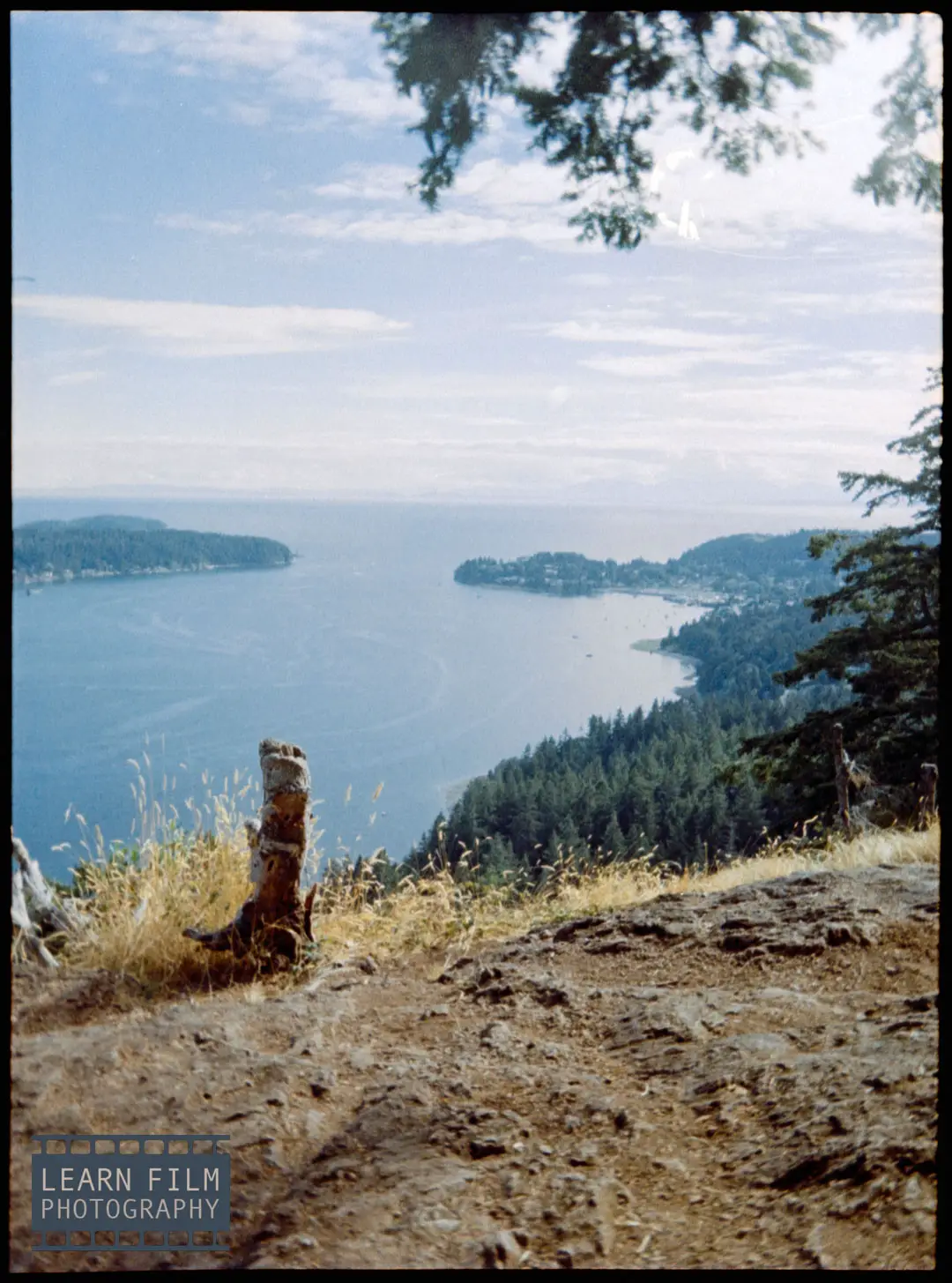Shooting film doesn’t have to be expensive. When prices on professional films like Kodak Portra keep rising, it’s no wonder consumers are looking for cheaper film options. Kodak Gold isn’t as flexible as Portra, but it creates that warm look that photographers go to film for in the first place. Here’s why I keep buying Kodak Gold.
Kodak Gold has a surprising tonal range for a consumer film, and creates incredible images that are perfect for capturing fun memories with friends and family, or even professionally in good light. Gold 200 will easily push 2 stops to ISO 800, and pull 3 stops down to ISO 25 and still produce beautifully saturated prints and scans.
And over this last year, I’ve been putting it to the paces. I’ve shot 40 rolls of Kodak film, and used it as my daily driver in everything from the Ilford Sprite 35-II camera (see why this is the most fun film camera of all time here) to my favorite Hasselblad Camera.
Overall, using this film has been a lot of fun. I’ve taken a lot of my favorite shots with it — especially summer evenings on the beach, walking around with a camera in hand. The lower price-point and warm glow it creates make this one of the film stocks I recommend the most to new film photographers. Get your Kodak Gold here on Amazon.






Who is Kodak Gold for?
If you’re new to film photography, you’ve probably been told over and over again how amazing Kodak Portra is. And to be fair, Portra is one of the the GOATs (Greatest Of All Time) in the film world. But a single roll of Portra 400 costs $25 in Canada right now, which means you have to really savor every shot — especially in 120 format. But with a cheaper roll of Kodak Gold in my camera, I’m not as worried about taking fun, experimental photos, or capturing memories.
But if I’m heading to a professional shoot and there’s still half a roll of Gold in my camera, I’m honestly not going to be worried. I’ll often just get a couple of warm up shots while setting up, which can sometimes even the favorites in the shoot. That’s the beauty of Kodak Gold — it lacks pretension, but it creates awesome images when you need it.
Kodak Gold will make the sharpest images with the most dynamic range at ISO 200, but can easily be pushed or pulled in changing light. But Kodak Gold can be shot between ISO 50 and ISO 400 on the same roll without push or pull processing, making it a fantastic film shooting at any time of day.
Need ISO 800 when it gets a bit darker? Kodak Gold creates good photos with slightly green shadows, and a little more saturation when push processed, but the images will still come out nicely.

How to Expose Kodak Gold for the best results

Getting a perfect exposure isn’t easy with film since you don’t get an immediate result. As well, it’s hard to know what went wrong when you only see the negatives a week, or even a couple months later. So getting the right exposure requires you to be proactive.
The general rule with film is to always expose for the shadows. Highlights are easily recovered with color negative film, but shadows usually what gets lost. So it’s always better to overexpose your images to capture more detail.
When underexposing, or pushing Kodak Gold, you’ll notice that the shadows become muddy and green when they’re shot around ISO 800. This can be a really cool look if that’s what you’re going for. In fact, it’s one of the main reasons why I keep shooting Kodak Gold, even when it starts to get dark. It’s fun to play around with beams of light for contrast.
But if you want to avoid those noisy green shadows, be sure to lower your shutter speed, or open the aperture to let in some more light.
Letting in more light feels counter-intuitive to pushing film. And it is. But the truth about film is that over-developing, or pushing, doesn’t increase the exposure as much as it does with digital photography.
Film is a physical medium. If there wasn’t enough light to excite the electrons in the silver halide emulsion, they won’t magically become developable with longer development times. Pushing film does allow the developer more time to work and find developable grains in the shadows, so there is a marginal speed increase. But it increase the image contrast, saturation, and graininess.

How to shoot Kodak Gold at night
Kodak Gold makes a surprisingly good night film. This shot here was taken using Kodak Gold in 120 format on my Hasselblad camera, and it shows just how versatile this film is.
You will get the best exposures on Kodak Gold at night by metering directly on the subject of your photo. Place your subject in good light, or wait for them to come to an area that has the best light so that you can have a decent shutter speed to make a good image. By placing your subject in the light, you are ensuring that they will be properly exposed, because the shadows will always disappear on the negative.
In this image here, I used a light meter app on my phone, which has a built in spot meter to get perfect exposure settings. Since this is a daylight balanced color film, it requires an exposure adjustment to get a perfect exposure.
I metered the scene as if I were using an ISO 100 film. Since the Hasselblad lenses are often a lot slower than 5mm camera lenses, I had to put the camera on a tripod and used a shutter speed of 1/15th of a second to get a perfect exposure, even if that meant having a little bit of motion blur from the cashier and other patrons.
Kodak Gold has a lot of overexposure latitude, so I knew that metering for the cashier would mean that I wouldn’t blow out the details on the neon sign outside, even though it’s significantly brighter.
Learn the best ways to take night photos on film, and how to calculate for reciprocity failure here.

Kodak Gold Limitations and Final Thoughts

There are a few limitations to Kodak Gold. The main downsides are that it isn’t as flexible for altering colors in post production as professional films, it’s a little more grainy, and it shouldn’t be pushed more than 2 stops.
In terms of spectral sensitivity, Kodak Gold sees a much greater loss of spectral sensitivity between the color forming layers than the professional films like Portra and Ektar. This means that there will be more contrast between colors than other films, which means that the negatives aren’t as flexible in post production.
But that’s no reason not to shoot it. I’ve used this film extensively over the last two years, and I have to say I always love the look of Kodak Gold over the professional films, because it’s fuss free. The results out of the scanner are almost always perfect, which Portra requires some work.
It’s not Portra, but Kodak Gold will give you 90% of the Portra experience, but with a warmer glow.
The lower cost of this film is what makes it so much fun. When I put Portra through my camera, there’s always a feeling that I have to be more serious and careful about what I’m taking a photo of.
And that can make me take forever to get images and end up with pent up expectations and underwhelming results. But I take more chances with Kodak Gold, and often come back with more of the fun images with less of the pretension. And for that reason, I’m never going to stop using this film.
Disclosure Statement: Some links on this blog post are affiliate links, which means that I receive a small commission on any sale resulting in those links clicked. This does not affect the prices of the items for sale, but it does help me continue blogging. All of these items are ones that I have used and bought with my own money. None of these items were gifted to me for the intended purpose of advertising. Read more about affiliate links in the affiliate policy.

By Daren
Daren is a journalist and wedding photographer based in Vancouver, B.C. He’s been taking personal and professional photos on film since 2017 and began developing and printing his own photos after wanting more control than what local labs could offer. Discover his newest publications at Soft Grain Books, or check out the print shop.


What is the Russian Leica that isn’t mentioned by name?
It’s the Zorki 6. Fantastic camera with an M39 screw mount. It’s honestly 80% as good as a Leica at 10% of the cost.